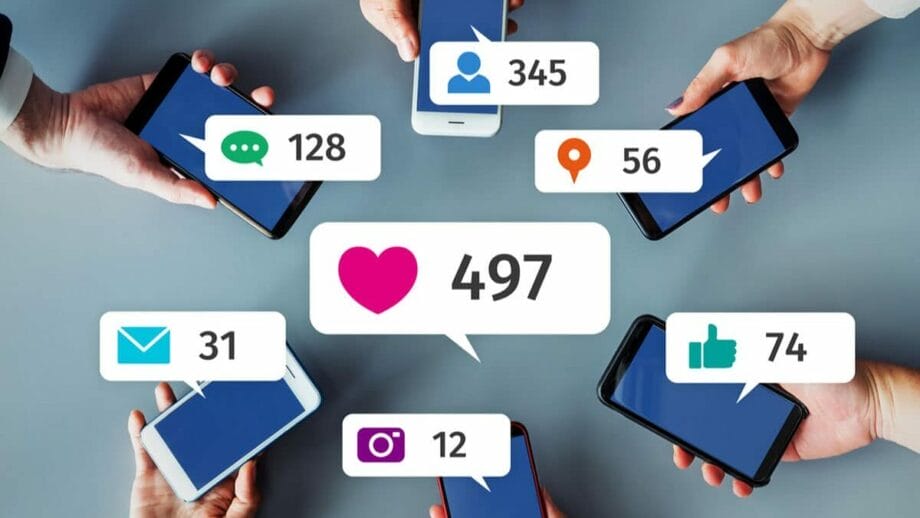Are you feeling lost in the vast digital marketing sea, trying to shout louder than your competitors? You’re not alone. Many brands find it challenging to stand out and connect with their target audience amidst the noise.
The key? A multi-channel digital marketing campaign that weaves together various platforms for a harmonious symphony of brand messages.
Success in today’s digital landscape hinges on a multi-channel marketing strategy that integrates various platforms to enhance customer engagement. A coherent plan that leverages each channel’s strengths can significantly improve ROI, as shown by Lytics Customer Data Platform’s 24% increase for multi-channel campaigns.
Start by defining your main objectives and understanding your audience to choose the right platforms and tailor your strategy effectively. Let’s explore deeper into multi-channel digital marketing.
Ready to amplify your voice? Keep reading!
Understanding Multi-Channel Digital Marketing

Multi-channel digital marketing is like a team sport. Just as in soccer, where you have forwards to score goals, defenders to protect your net, and midfielders to connect plays, in digital marketing, we use different platforms to create a unified strategy.
Think of social media as the forward line – always on the attack, engaging directly with fans through posts and comments. Websites and blogs act like defenders; they’re your home base, protecting your brand’s image by providing deep insights and valuable content.
Then there’s email marketing and PPC advertising playing midfield – connecting your message directly to specific parts of your audience with personalized emails and targeted ads.
I’ve seen firsthand how leveraging these varied channels can elevate a simple ad campaign into a robust customer journey that hits all the right notes from awareness straight through to conversion.
It involves juggling multiple elements – understanding where your audience hangs out online (be it Facebook or LinkedIn), crafting messages that resonate across different mediums from video clips on Instagram to thought leadership articles on industry blogs – and then making sure these channels talk to each other smoothly for an omnichannel experience that feels both personal and consistent.
The goal? To meet potential customers wherever they are, using data-driven insights from tools like HubSpot for automation and Google Analytics for tracking performance across this multi-touch landscape.
This kind of strategy boosts not just clicks but real engagement – turning casual browsers into loyal customers who feel understood at every touchpoint along their buying journey. And trust me – as someone who has navigated the tightrope between online forums brimming with influencers talking about the next big thing in mobile marketing or deciphering analytic dashboards – it pays off not just in cool likes or shares but real ROI for business growth.
Best Practices for Creating a Multi-Channel Digital Marketing Campaign

We will next discuss the processes for approaching your campaigns to guarantee that your marketing is headed in the correct direction and provides outstanding outcomes. You’ll want clear goals and to know who you’re talking to.
Picking platforms that fit, making content fun, using strategies across places, and checking how well you did are steps you can’t skip.
1. Define Your Goals and Target Audience
“Understanding who you’re talking to makes choosing where to talk much simpler.”
Defining objectives and understanding your target audience is crucial for a successful digital marketing strategy. Start by setting SMART goals, such as increasing website traffic by 20% in three months, to provide clear direction and track progress.
Break down your main goal into actionable tasks, like creating engaging content and utilizing social media. Next, define your target audience by researching their demographics, interests, and online habits to create detailed buyer personas.
This knowledge helps tailor your marketing efforts and select the best platforms for your campaign.
I once worked on a campaign that set out to boost brand awareness among young adults aged 18-24 using social media marketing through platforms like TikTok and Instagram due to their preference for visual content.
Our detailed market research showed us exactly where our target audience spent most of their time online which made it easier for us to engage with them effectively. We learned quickly that profiles built around real consumer behaviors drove our content strategy successfully.
Now let’s evaluate different platforms to find the best fit for your audience and goals.
2. Choose the Right Platforms
Selecting suitable platforms is key to a successful multi-channel marketing strategy. It ensures your message reaches the right people in places they spend their time online. So, here’s what you need to think about:
- Identify your target audience: Really get into who they are. What do they like? Where do they hang out online? This step is crucial because 91% of retail brands tap into multiple social media channels to connect with diverse audiences.
- Research the platforms: Analyze each potential platform’s nuts and bolts. Look at social media for broad reach and engagement, search engine marketing and advertising for those actively searching, email marketing for direct and personalized communication, and content marketing for storytelling and depth.
- Consider your resources: Be real about what you can handle in terms of time, team, and money. Facebook and Instagram demand creativity and frequent posts but offer a huge audience and advanced targeting options. LinkedIn is unbeatable for B2B connections but requires a more formal approach. Twitter suits those who can engage with trending topics rapidly.
Here’s a quick comparison of some popular platforms:
| Platform | Best for | Key features |
|---|---|---|
| Broad audience reach | Advanced targeting options, diverse ad formats | |
| Quick Note: With its broad reach and deep targeting features, I’ve managed campaigns that precisely reached my desired audience segments – increasing brand awareness significantly. | ||
| Visual content | High engagement rates, Stories, and Reels | |
| Quick Note: Its high-engagement nature paired with stunning visuals has driven up my engagement rates through influencer partnerships that perfectly showcased products in real-life settings. | ||
| B2B marketing | Professional networking, lead generation | |
| Quick Note: For B2B marketers like me, it’s gold. Sharing thought leadership content has nurtured leads by positioning my brand as an industry expert. | ||
| Real-time updates | Hashtags, trending topics | |
| Quick Note: It’s all about speed here – jumping onto trending topics quickly boosted my brand’s visibility in broader conversations. | ||
| Email Marketing | Direct communication | Personalization, automation |
| Quick Note: Personalization via email has directly led to higher conversion rates as I could customize messages based on customer behavior and preferences captured through predictive analytics tools. | ||
By carefully selecting platforms based on where your target audience spends most of their time online and aligning this choice to available resources ensures marketing efforts are efficient; not just casting a wide net hoping for the best results.

3. Create Engaging Content
Creating engaging content is crucial for a successful multi-channel digital marketing campaign. Customize video, text, and images for each platform to captivate and engage your audience.
Key considerations:
- Know your audience’s sweet spot: Research what content resonates on each platform. For example, short videos on TikTok for younger audiences or in-depth blogs on LinkedIn for professionals.
- Focus on value, not just promotion: Create content that is interesting, informative, or entertaining. Provide value to attract attention.
- Spark conversation and interaction: Encourage engagement through questions, polls, and contests to build a community around your brand.
Customizing your message means understanding the distinctions across social media platforms, search engines like Google for SEO efforts, and even email campaigns where direct personalization can boost customer experiences significantly.
It’s not just about making noise but ensuring the right people hear it at the right time via online ads or catchy display ads that align with their interests or solve their problems – maybe through how-to guides or thoughtful vlogs that showcase your brand’s human side.
Key elements also include integrating influencers into your strategy who can amplify your voice within niche communities or employing marketing automation tools that ensure timely publication across channels without missing any touchpoints with potential customers.
Personalizing content for each platform and prioritizing audience engagement will lead to a successful multi-channel campaign. Next, we’ll explore applying these content strategies on different platforms for maximum impact – keeping in mind always to measure performance using data analytics so you can see what works best where improving ROI with every piece of creative asset sent out into digital conversation.
4. Implement Cross-Platform Strategies
Maximizing your digital marketing strategy involves efficient cross-platform methods for a seamless and engaging audience experience. These strategies ensure your message stays strong across all channels, from social media to email.
Key strategies:
- Cross-Platform promotion: Make sure to lead your followers from one place to another. For example, show a sneak peek of a video on Instagram and tell viewers the full version is on YouTube.
- Optimize for cross-channel conversions: Your call to action should feel natural no matter where it appears. Whether someone sees it in an email or on Twitter, they should know what to do next.
- Platform-targeted content creation: Tailor your messages for each platform but keep your main idea the same. This means making posts that fit well whether they’re seen on Facebook or read in an email.
- Centralized analytics dashboard: Use tools like Google Analytics to see how all parts of your campaign are doing in one place. This lets you make smarter decisions about where to focus next.
- Cross-platform retargeting: Bring back visitors who didn’t convert by using ads that follow them from Google search results to Facebook feeds and beyond.
Implementing these techniques creates a coherent and successful digital marketing campaign. Next, we’ll discuss the importance of tracking your marketing efforts.
5. Measure Your Campaign Performance
So, you’ve put your multi-channel digital marketing plan into action. Now comes the critical part: tracking how well it’s doing.
- Tracking the effectiveness of your multi-channel digital strategy is a must to see what hits the mark and what misses. You want to keep an eye on specific key performance indicators (KPIs) such as engagement rates, conversion rates, and return on investment (ROI).
- Use analytics tools – think Google Analytics or Adobe Analytics – for a deep analysis of these metrics. They show you how users interact with your ads and content across different platforms.
- High engagement rates are good news; they mean people are paying attention to your content. But if those high fives don’t turn into action – like signing up or buying – you might need to rethink your calls-to-action or landing pages.
- Conversion rates give you the lowdown on how many users go from just looking to taking the plunge and completing desired actions like filling out forms or making purchases.
- Calculating ROI tells you if the game is worth the candle; it measures whether the benjamins spent on campaigns are coming back as more benjamins in sales or leads.
- I learned from personal experience that regular check-ins with these metrics can transform a so-so campaign into a winner. Real-time data let me tweak my strategies on the fly – adjusting keywords here, re-targeting there – to boost my campaign’s success.
- This performance evaluation isn’t a one-and-done deal but an ongoing effort that helps refine and direct marketing efforts for maximum impact and efficiency.
- A mix of high engagement without corresponding conversions might signal a disconnect somewhere in your user experience or messaging. It points out where to zoom in for improvements.
So, staying dialed into these indicators sheds light on your campaign’s health and guides adjustments for better reach and results over time, enhancing both customer satisfaction and brand recognition through effective online advertising and search engine optimization efforts.
Conclusion

Businesses today need a strong plan that talks to everyone, everywhere. They must know who they’re speaking to and what they want to achieve. Choosing the right places online makes sure their message is heard loud and clear.
Mixing different digital channels lets customers get a smooth, united experience every time they see your brand. Keep an eye on how well things are going, and be ready to change tactics when needed.
With this approach, brands can talk to more people, get them involved, and move forward faster. Your business isn’t just shouting into the void – it’s part of a big conversation. Get out there; show what you’ve got!



